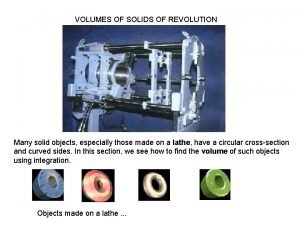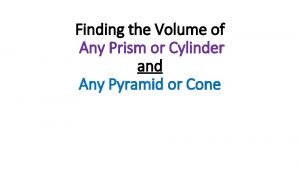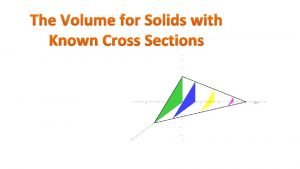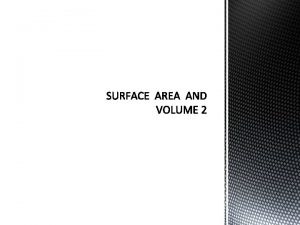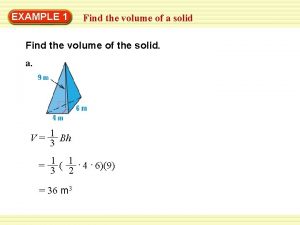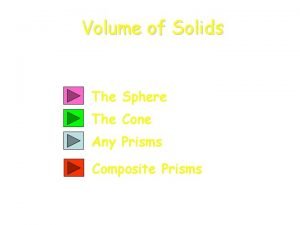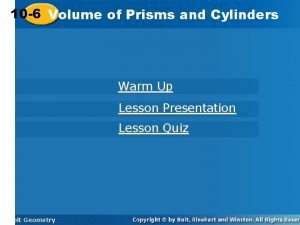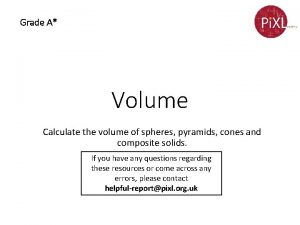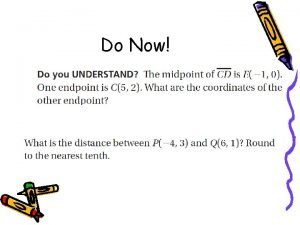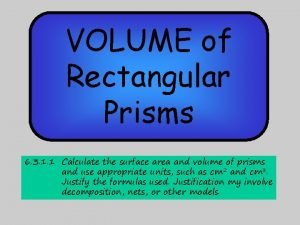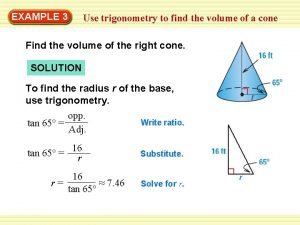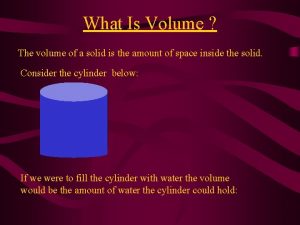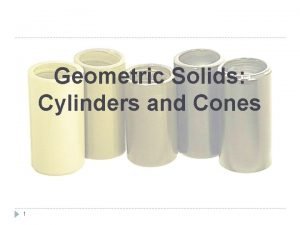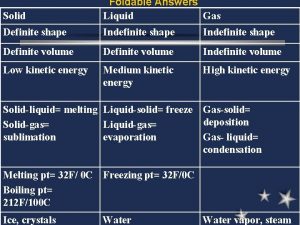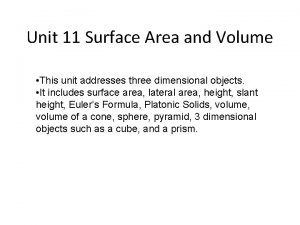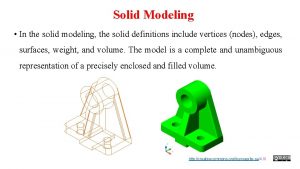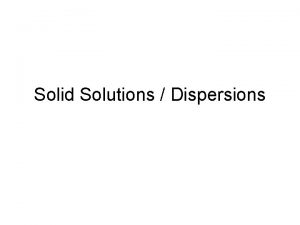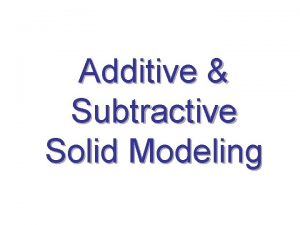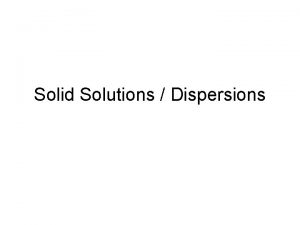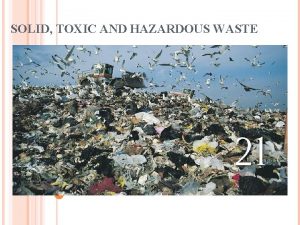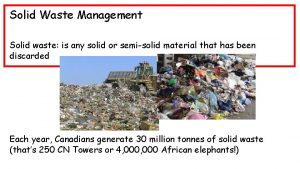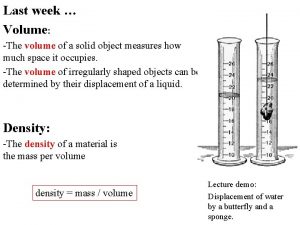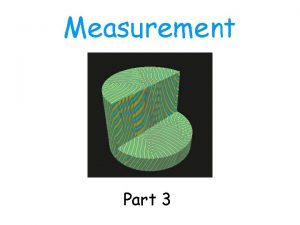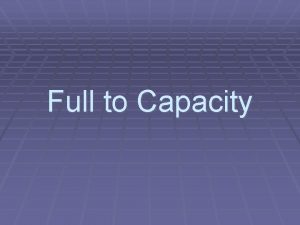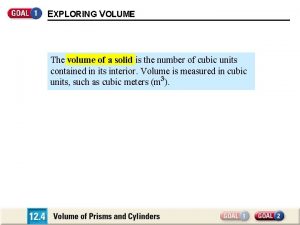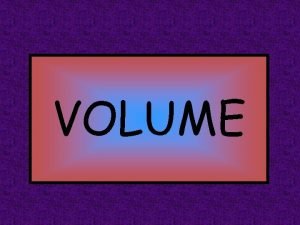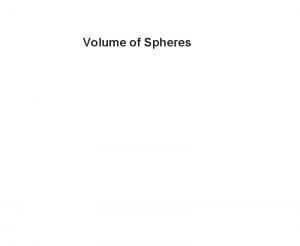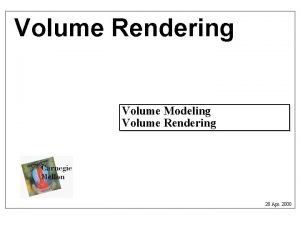Volume Defn Volume The volume of a solid






































































- Slides: 70

Volume

Defn Volume • The volume of a solid is the amount of space it occupies. In other words, it is the number of cubes which fit inside. • Volume is measured in either cm 3 or m 3 Here is a cubic centimetre: It is a cube which measures 1 cm in all directions. 1 cm 1 cm

Defn Polyhedron: A solid three dimensional shape, with flat faces e. g:

Defn Cuboid: • A cuboid, is a polyhedron with six rectangular plane faces • E. g:

Defn: Prism • A prism is a solid with two opposite faces that are the same shape, size and are parallel. I. e. it has the same cross-section for the entire length of the shape.

The following are all prisms Cylinder Cuboid Cross section Trapezoid Prism Triangular Prism Volume of Prism = length x Cross-sectional area

Volumes Of Cuboids. Look at the cuboid below: 4 cm 3 cm 10 cm We must first calculate the area of the base of the cuboid: The base is a rectangle measuring 10 cm by 3 cm: 10 cm 3 cm

10 cm 3 cm Area of a rectangle = length x breadth Area = 10 x 3 Area = 30 cm 2 We now know we can place 30 centimetre squares on the base of the cuboid. But we can also place 30 cubic centimetres on the base: 4 cm 3 cm 10 cm

4 cm 3 cm 10 cm We have now got to find how many layers of 1 cm cubes we can place in the cuboid: We can fit in 4 layers. Volume = 30 x 4 Volume = 120 cm 3 That means that we can place 120 of our cubes measuring a centimetre in all directions inside our cuboid.

• The Volume of a prism is simply the area of one end times the length of the prism

4 cm 3 cm 10 cm We have found that the volume of the cuboid is given by: Volume = 10 x 3 x 4 = 120 cm 3 This gives us our formula for the volume of a cuboid: Volume = Length x Breadth x Height V=LBH for short.

Do we need to see that again? How to find volume 3 x 6 = 18 cubes x 4 lots = 72 cubes


Find the volume of the following? Calculate the volumes of the cuboids below: (1) 7 cm (2) 3. 4 cm 5 cm 14 cm 490 cm 3 (3) 3. 4 cm 39. 3 cm 3 3. 2 m 2. 7 m 8. 9 m 76. 9 m 3


The Cone A Cone is a three dimensional solid with a circular base and a curved surface that gradually narrows to a vertex. + + Volume of a Cone = =

Pyramids A Pyramid is a three dimensional figure with a regular polygon as its base and all the outside faces are identical isosceles triangles meeting at a point. Identical isosceles triangles base = quadrilateral base = pentagon base = heptagon

Volume of Pyramids Volume of a Pyramid: V = (1/3) Area of the base x height V = (1/3) Ah Volume of a Pyramid = 1/3 x Volume of a Prism + + =


The Cross Sectional Area. When we calculated the volume of the cuboid : 4 cm 3 cm 10 cm We found the area of the base : This is the Cross Sectional Area. The Cross section is the shape that is repeated throughout the volume. We then calculated how many layers of cross section made up the volume. This gives us a formula for calculating other volumes: Volume = Cross Sectional Area x Length.

For the solids below identify the cross sectional area required for calculating the volume: (1) (2) Circle Right Angled Triangle. (4) (3) A 2 A 1 Pentagon Rectangle & Semi Circle.

The Volume Of A Cylinder. Consider the cylinder below: 6 cm 4 cm The formula for the volume of a cylinder is: V = r 2 h r = radius h = height. It has a height of 6 cm. What is the size of the radius ? 2 cm Volume = cross section x height What shape is the cross section? Circle Calculate the area of the circle: A = r 2 A = 3. 14 x 2 A = 12. 56 cm 2 Calculate the volume: V = r 2 x h V = 12. 56 x 6 V = 75. 36 cm 3

The Volume Of A Triangular Prism. Consider the triangular prism below: 5 cm 8 cm 5 cm The formula for the volume of a triangular prism is : V=½bhl B= base h = height l = length Volume = Cross Section x Height What shape is the cross section ? Triangle. Calculate the area of the triangle: A = ½ x base x height A = 0. 5 x 5 A = 12. 5 cm 2 Calculate the volume: Volume = Cross Section x Length V = 12. 5 x 8 V = 100 cm 3


What Goes In The Box ? 2 Calculate the volume of the shapes below: (1) (2) 14 cm 2813. 4 cm 3 4 m 5 m 16 cm 3 m (3) 30 m 3 8 m 6 cm 12 cm 288 cm 3

More Complex Shapes. Calculate the volume of the shape below: 12 m Calculate the volume: 16 m A 1 Volume = Cross sectional area x length. V = 256 x 23 V = 2888 m 3 A 2 23 m 20 m Calculate the cross sectional area: Area = A 1 + A 2 Area = (12 x 16) + ( ½ x (20 – 12) x 16) Area = 192 + 64 Area = 256 m 2

Example 2. Calculate the volume of the shape below: A 2 10 cm A 1 Calculate the volume. Volume = cross sectional area x Length 18 cm 12 cm V = 176. 52 x 18 V = 3177. 36 cm 3 Calculate the cross sectional area: Area = A 1 + A 2 Area = (12 x 10) + ( ½ x x 6 ) Area = 120 +56. 52 Area = 176. 52 cm 2

What Goes In The Box ? 3 11 m (1) 4466 m 3 14 m 22 m (2) 18 m 17 cm 19156. 2 cm 3 23 cm 32 cm


Other slides:

Volumes Of Solids. 5 m 7 cm 8 m 5 cm 14 cm 6 cm 4 cm 3 cm 10 cm

What Is Volume ? The volume of a solid is the amount of space inside the solid. In other words it is the number of cubes which fit inside. Consider the cylinder below: If we were to fill the cylinder with water the volume would be the amount of water the cylinder could hold:

Measuring Volume is measured in cubic centimetres (also called centimetre cubed). Here is a cubic centimetre It is a cube which measures 1 cm in all directions. 1 cm 1 cm We will now see how to calculate the volume of various shapes.

Volumes Of Cuboids. Look at the cuboid below: 4 cm 3 cm 10 cm We must first calculate the area of the base of the cuboid: The base is a rectangle measuring 10 cm by 3 cm: 10 cm 3 cm

10 cm 3 cm Area of a rectangle = length x breadth Area = 10 x 3 Area = 30 cm 2 We now know we can place 30 centimetre squares on the base of the cuboid. But we can also place 30 cubic centimetres on the base: 4 cm 3 cm 10 cm

4 cm 3 cm 10 cm We have now got to find how many layers of 1 cm cubes we can place in the cuboid: We can fit in 4 layers. Volume = 30 x 4 Volume = 120 cm 3 That means that we can place 120 of our cubes measuring a centimetre in all directions inside our cuboid.

4 cm 3 cm 10 cm We have found that the volume of the cuboid is given by: Volume = 10 x 3 x 4 = 120 cm 3 This gives us our formula for the volume of a cuboid: Volume = Length x Breadth x Height V=LBH for short.

What Goes In The Box ? Calculate the volumes of the cuboids below: (1) 7 cm (2) 3. 4 cm 5 cm 14 cm 490 cm 3 (3) 3. 4 cm 39. 3 cm 3 3. 2 m 2. 7 m 8. 9 m 76. 9 m 3

The Cross Sectional Area. When we calculated the volume of the cuboid : 4 cm 3 cm 10 cm We found the area of the base : This is the Cross Sectional Area. The Cross section is the shape that is repeated throughout the volume. We then calculated how many layers of cross section made up the volume. This gives us a formula for calculating other volumes: Volume = Cross Sectional Area x Length.

For the solids below identify the cross sectional area required for calculating the volume: (1) (2) Circle Right Angled Triangle. (4) (3) A 2 A 1 Pentagon Rectangle & Semi Circle.

The Volume Of A Cylinder. Consider the cylinder below: 6 cm 4 cm The formula for the volume of a cylinder is: V = r 2 h r = radius h = height. It has a height of 6 cm. What is the size of the radius ? 2 cm Volume = cross section x height What shape is the cross section? Circle Calculate the area of the circle: A = r 2 A = 3. 14 x 2 A = 12. 56 cm 2 Calculate the volume: V = r 2 x h V = 12. 56 x 6 V = 75. 36 cm 3

The Volume Of A Triangular Prism. Consider the triangular prism below: 5 cm 8 cm 5 cm The formula for the volume of a triangular prism is : V=½bhl B= base h = height l = length Volume = Cross Section x Height What shape is the cross section ? Triangle. Calculate the area of the triangle: A = ½ x base x height A = 0. 5 x 5 A = 12. 5 cm 2 Calculate the volume: Volume = Cross Section x Length V = 12. 5 x 8 V = 100 cm 3

What Goes In The Box ? 2 Calculate the volume of the shapes below: (1) (2) 14 cm 2813. 4 cm 3 4 m 5 m 16 cm 3 m (3) 30 m 3 8 m 6 cm 12 cm 288 cm 3

More Complex Shapes. Calculate the volume of the shape below: 12 m Calculate the volume: 16 m A 1 Volume = Cross sectional area x length. V = 256 x 23 V = 2888 m 3 A 2 23 m 20 m Calculate the cross sectional area: Area = A 1 + A 2 Area = (12 x 16) + ( ½ x (20 – 12) x 16) Area = 192 + 64 Area = 256 m 2

Example 2. Calculate the volume of the shape below: A 2 10 cm A 1 Calculate the volume. Volume = cross sectional area x Length 18 cm 12 cm V = 176. 52 x 18 V = 3177. 36 cm 3 Calculate the cross sectional area: Area = A 1 + A 2 Area = (12 x 10) + ( ½ x x 6 ) Area = 120 +56. 52 Area = 176. 52 cm 2

What Goes In The Box ? 3 11 m (1) 4466 m 3 14 m 22 m (2) 18 m 17 cm 19156. 2 cm 3 23 cm 32 cm

Volume Of A Cone. Consider the cylinder and cone shown below: D D The diameter (D) of the top of the cone and the cylinder are equal. H H The height (H) of the cone and the cylinder are equal. If you filled the cone with water and emptied it into the cylinder, how many times would you have to fill the cone to completely fill the cylinder to the top ? 3 times. This shows that the cylinder has three times the volume of a cone with the same height and radius.

The experiment on the previous slide allows us to work out the formula for the volume of a cone: The formula for the volume of a cylinder is : V = r 2 h We have seen that the volume of a cylinder is three times more than that of a cone with the same diameter and height. The formula for the volume of a cone is: r h r = radius h = height

Calculate the volume of the cones below: (1) (2) 6 m 9 m 18 m 13 m

Summary Of Volume Formula. r h h b l V=lbh V = r 2 h h r h b l V=½bhl




The Cone A Cone is a three dimensional solid with a circular base and a curved surface that gradually narrows to a vertex. + + Volume of a Cone = =

Exercise #1 Find the volume of a cylinder with a radius r=1 m and height h=2 m. Find the volume of a cone with a radius r=1 m and height h=1 m Volume of a Cylinder = base x height = pr 2 h = 3. 14(1)2(2) = 6. 28 m 3 Volume of a Cone (1/3) pr 2 h = (1/3)(3. 14)(1)2(2) = 2. 09 m 3 =

Surface Area of a Cone Find the area of a cone with a radius r=3 m and height h=4 m. r = the radius Use the Pythagorean Theorem to find l l 2 = r 2 + h 2 l 2= (3)2 + (4)2 l 2= 25 l=5 h = the height l = the slant height Surface Area of a Cone = pr 2 + prl = 3. 14(3)2 + 3. 14(3)(5) = 75. 36 m 2

Pyramids A Pyramid is a three dimensional figure with a regular polygon as its base and lateral faces are identical isosceles triangles meeting at a point. Identical isosceles triangles base = quadrilateral base = pentagon base = heptagon

Volume of Pyramids Volume of a Pyramid: V = (1/3) Area of the base x height V = (1/3) Ah Volume of a Pyramid = 1/3 x Volume of a Prism + + =

Exercise #2 Find the volume of the pyramid. height h = 8 m apothem a = 4 m side s=6 m Volume = 1/3 (area of base) (height) = 1/3 ( 60 m 2)(8 m) = 160 m 3 h s a Area of base ½ Pa = ½ (5)(6)(4) = = 60 m 2

Area of Pyramids Find the surface area of the pyramid. height h = 8 m apothem a = 4 m side s=6 m Surface Area = area of base + 5 (area of one lateral face) What shape is the base? h l s a Area of a pentagon = ½ Pa = ½ (5)(6)(4) = 60 m 2

Area of Pyramids Find the surface area of the pyramid. height h = 8 m apothem a = 4 m side s=6 m What shape are the lateral sides? Area of a triangle = ½ base (height) = ½ (6)(8. 9) = 26. 7 m 2 h l s a Attention! the height of the triangle is the slant height ”l ” l 2 = h 2 + a 2 = 8 2 + 42 = 80 m 2 l = 8. 9 m

Area of Pyramids Find the surface area of the pyramid. height h = 8 m apothem a = 4 m side s=6 m h l s a Surface Area of the Pyramid = 60 m 2 + 5(26. 7) m 2 = 60 m 2 + 133. 5 m 2 = 193. 5 m 2



A Prism Cylinder Cuboid Cross section Trapezoid Prism Triangular Prism Volume of Prism = length x Cross-sectional area

Area Formulae r h Area Circle = π x r 2 b Area Rectangle = Base x height a h b Area Trapezium = ½ x (a + b) x h h b Area Triangle = ½ x Base x height

Volume Cylinder Cross-sectional Area = π x r 2 = π x 32 = 28. 2743…. . cm 2 DO NOT ROUND! 3 cm 5 cm USE CALCULATOR ‘ANS’! Volume = length x CSA = 5 x 28. 2743…. = 141. 3716…. cm 3 = 141. 4 cm 3

Volume Cuboid Cross-sectional Area = b x h = 7. 2 x 5. 3 = 38. 16 cm 2 5. 3 cm 10. 6 cm DO NOT ROUND! 7. 2 cm Volume = length x CSA USE ‘ANS’! = 10. 6 x 38. 16 = 404. 496 cm 3 = 404. 5 cm 3 Sensible degree of accuracy

Volume Trapezoid Prism Cross-sectional Area = ½ x(a + b) x h = ½ x (6. 3 + 1. 7) x 4. 9 = 19. 6 cm 2 6. 3 cm 4. 9 cm DO NOT ROUND! 8. 2 cm 1. 7 cm Volume = length x CSA USE ‘ANS’! = 19. 6 x 8. 2 = 160. 72 cm 3 = 160. 7 cm 3 Sensible degree of accuracy

Volume Triangular Prism Cross-sectional Area = ½ x b x h = ½ x 8. 6 x 4. 1 = 17. 63 cm 2 4. 1 cm 4. 9 cm DO NOT ROUND! 6. 2 cm 8. 6 cm Volume = length x CSA USE ‘ANS’! = 17. 63 x 6. 2 = 109. 306 cm 3 = 109. 3 cm 3 Sensible degree of accuracy
 Interpenetration of surfaces
Interpenetration of surfaces Solution solid example
Solution solid example Crystalline solid and amorphous solid
Crystalline solid and amorphous solid Filtration separating mixtures examples
Filtration separating mixtures examples Covalent molecular and covalent network
Covalent molecular and covalent network Crystalline substances
Crystalline substances Crystalline solid and amorphous solid
Crystalline solid and amorphous solid When a solid completely penetrates another solid
When a solid completely penetrates another solid Crystalline or amorphous
Crystalline or amorphous Crystal solid and amorphous solid
Crystal solid and amorphous solid Hổ sinh sản vào mùa nào
Hổ sinh sản vào mùa nào Lời thề hippocrates
Lời thề hippocrates đại từ thay thế
đại từ thay thế Quá trình desamine hóa có thể tạo ra
Quá trình desamine hóa có thể tạo ra Vẽ hình chiếu vuông góc của vật thể sau
Vẽ hình chiếu vuông góc của vật thể sau Cong thức tính động năng
Cong thức tính động năng Thế nào là mạng điện lắp đặt kiểu nổi
Thế nào là mạng điện lắp đặt kiểu nổi Dot
Dot Bổ thể
Bổ thể Vẽ hình chiếu đứng bằng cạnh của vật thể
Vẽ hình chiếu đứng bằng cạnh của vật thể Phản ứng thế ankan
Phản ứng thế ankan Các môn thể thao bắt đầu bằng tiếng đua
Các môn thể thao bắt đầu bằng tiếng đua Sự nuôi và dạy con của hổ
Sự nuôi và dạy con của hổ điện thế nghỉ
điện thế nghỉ Một số thể thơ truyền thống
Một số thể thơ truyền thống Nguyên nhân của sự mỏi cơ sinh 8
Nguyên nhân của sự mỏi cơ sinh 8 Trời xanh đây là của chúng ta thể thơ
Trời xanh đây là của chúng ta thể thơ Các số nguyên tố
Các số nguyên tố Thiếu nhi thế giới liên hoan
Thiếu nhi thế giới liên hoan Tỉ lệ cơ thể trẻ em
Tỉ lệ cơ thể trẻ em Fecboak
Fecboak Các châu lục và đại dương trên thế giới
Các châu lục và đại dương trên thế giới Thế nào là hệ số cao nhất
Thế nào là hệ số cao nhất Sơ đồ cơ thể người
Sơ đồ cơ thể người Tư thế ngồi viết
Tư thế ngồi viết Bàn tay mà dây bẩn
Bàn tay mà dây bẩn Hát kết hợp bộ gõ cơ thể
Hát kết hợp bộ gõ cơ thể đặc điểm cơ thể của người tối cổ
đặc điểm cơ thể của người tối cổ Mật thư anh em như thể tay chân
Mật thư anh em như thể tay chân Tư thế worm breton là gì
Tư thế worm breton là gì Tư thế ngồi viết
Tư thế ngồi viết ưu thế lai là gì
ưu thế lai là gì Voi kéo gỗ như thế nào
Voi kéo gỗ như thế nào Thẻ vin
Thẻ vin Thể thơ truyền thống
Thể thơ truyền thống Các châu lục và đại dương trên thế giới
Các châu lục và đại dương trên thế giới Từ ngữ thể hiện lòng nhân hậu
Từ ngữ thể hiện lòng nhân hậu Diễn thế sinh thái là
Diễn thế sinh thái là Giọng cùng tên là
Giọng cùng tên là Làm thế nào để 102-1=99
Làm thế nào để 102-1=99 Chúa sống lại
Chúa sống lại Volume of disc
Volume of disc How do you find the volume of any prism or cylinder?
How do you find the volume of any prism or cylinder? Volumes of solids with known cross sections
Volumes of solids with known cross sections Find the volume of the composite solid.
Find the volume of the composite solid. Liquid homogeneous mixture
Liquid homogeneous mixture How to find volume of hemisphere
How to find volume of hemisphere Find the volume of the shaded solid below
Find the volume of the shaded solid below Trapezoid volume
Trapezoid volume Composite solid volume
Composite solid volume Pool full of water
Pool full of water Calculate the volume of the pyramid
Calculate the volume of the pyramid The volume of a solid is measured in units cubed. truefalse
The volume of a solid is measured in units cubed. truefalse Lxwch
Lxwch Funnel volume formula
Funnel volume formula Volume of a solid
Volume of a solid Lateral surface area formula
Lateral surface area formula Solid liquid gas foldable
Solid liquid gas foldable Volume of a composite solid
Volume of a composite solid Unit 11 volume and surface area
Unit 11 volume and surface area



















































